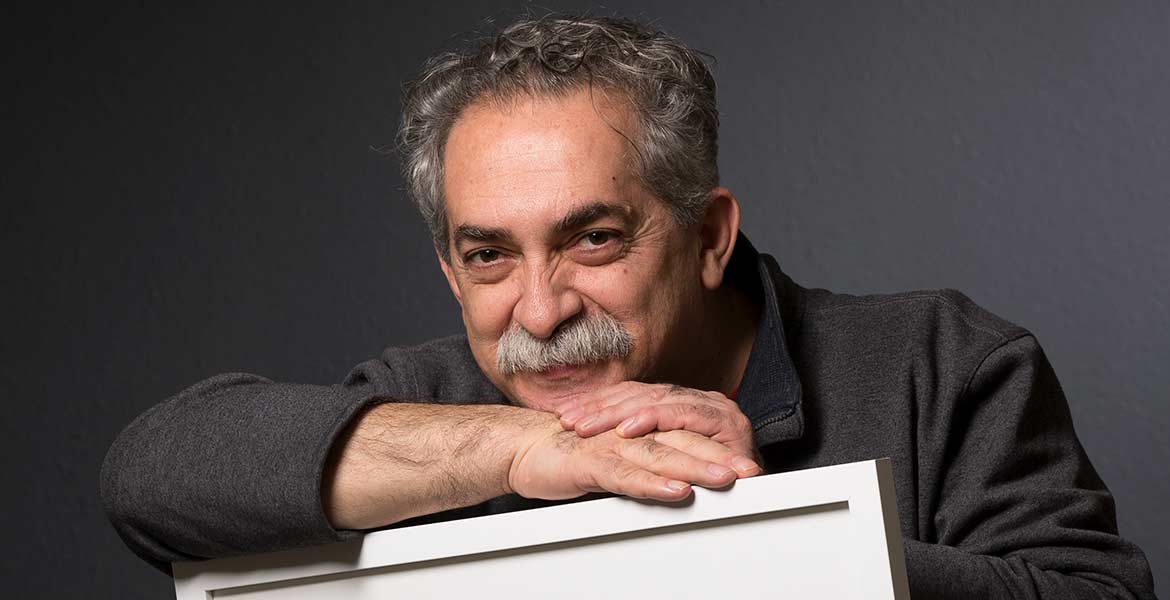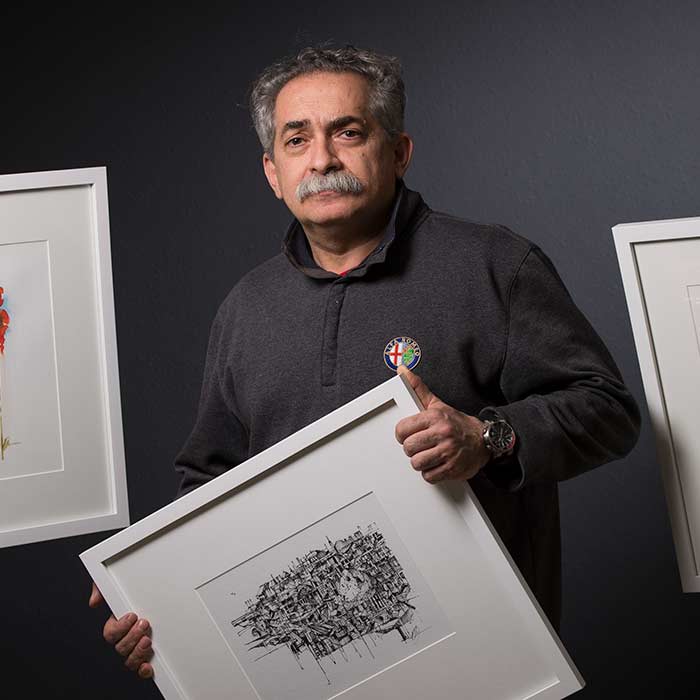
Drawn to Create
Wednesday, May 1, 2019
"I think talent is whenever a person's aspiration match their ability. You have to work on you ability so it will match your drive and aspirations. If you want it, if you love it, you will excel at it."
Imaginative. Inspirational. Energizing.
These are a few of the traits that best describe longtime Oklahoma State University
eminent professor of architecture Dr. Moh’d Bilbeisi and the creative process for
his own work and what he hopes to instill in students.
“Art is not about producing pretty pictures,” he said. “Pretty pictures are illustration. Art is whenever you are seeing it differently, you produce it and people see it through you.”
Bilbeisi carries a sketchbook everywhere he goes and draws or paints to practice his craft.
Ideas come from watching and reading news and simply paying attention to the world around him.
“I don’t believe in talent,” Bilbeisi said. “I think talent is whenever a person’s aspirations match their ability. You have to work on your ability so it will match your drive and aspirations. If you want it, if you love it, you will excel at it.”
Bilbeisi sleeps about three hours each night, waking up about 3 a.m. to catch up on news, respond to emails, drink his morning coffee and paint.
“Whenever you see my work it looks chaotic; however, there is a methodology that is embedded within it,” Bilbeisi said. “I’m able to extract order from chaos. Sometimes I capture tragedy and beauty at the same time.”
His artwork ranges from the destructive 2018 Camp Fire in northern California to expressive portraits to eye-catching images of motorcycles and automobiles.
As a child, Bilbeisi wanted to be a racecar driver. Though that never materialized, his passion for the architectural craftsmanship has gotten him illustration work with Porsche, among others.
“People ask why vehicles like a Ferrari or Porsche are so expensive,” Bilbeisi said. “It’s because you are paying for the thought process behind it.”
Thought-provoking art
Bilbeisi is hopeful people viewing his art also take time to consider what it may be trying to say.
“I bare myself,” he said. “Some people get it, some don’t. Some hate it. And that’s OK. I’m not here to make you feel better. I want to make people think.”
In addition to teaching an architectural design course, Bilbeisi initiated Advanced Graphics and Theory of Presentation — a class that asks how people visually communicate and why — and History Theory of Islamic Architecture. He said that class is unique because about 40 percent of the course is focused on culture and demographics with the rest on architecture.
“It is based on the premise that you will never understand the architecture unless you understand the culture,” he said.
Bilbeisi came to OSU as a 16-year-old international student from Jordan, earning a bachelor’s and doctorate in architecture. He began teaching at the university in 1998.

Inspiring students to dream
He doesn’t test his students through memorization or answers to true or false questions and instead asks conceptual questions, seeking to hear students’ opinions that are supported by facts.
“Educating students is what makes it all worthwhile,” said Bilbeisi, a self-described Albert Einstein lookalike. “With all the things that are going on in this world, it is nice to be in an environment in which it’s idealistic. I know how to teach students to dream and that is by inspiring them. Gaining knowledge isn’t sufficient. You need to inspire by being a role model.”
Bilbeisi has authored several books. He calls Graphic Journaling, which introduces students to the concept and teaches them the benefits of keeping a journal, his favorite.
He has also won countless architecture awards.
“Seeking accolades for the sake of accolades is bad,” Bilbeisi said. “But it is nice at my age to start to be recognized for things I seeded a long time ago. I have won all the prestigious awards that are relevant to my research and to my interests.”
"I plant the seeds, and hopefully they will grow/ OSU is a fertile environment where everyone could thrive."
Passing on a passion
Bilbeisi hopes some of his students have the same passion and love of architecture that he does.
“I plant the seeds, and hopefully they will grow,” Bilbeisi said. “OSU is a fertile environment where everyone could thrive. I’m at the age that my students are becoming professionals, and I’m seeing what they are capable of doing. There is a lot of pride that goes into it. I think I live vicariously through them, which makes me very, very happy.”
Dylan Hames — a 2014 graduate who is busy designing Google office buildings while working at Bjarke Ingels Group in New York — credits Bilbeisi for much of his professional success.
“Sketching is the common language of all architects, surpassing any software or technology, connecting us with the ancients,” Hames said. “What makes Moh’d a critical underpinning for the school is that, ironically, he destabilizes. He breaks down to rebuild, often challenging young students’ perceptions of their world. There is always the other side, and it deserves equal scrutiny.
“The greatest skill Moh’d imparts on his students and possibly the calling card of OSU architecture grads in the region, is the ability to get what’s in your brain onto a piece of paper. When you study architecture, you become deeply connected with your professors. They’re there with you in studio for five years, late into the night, and they've seen you at your best and worst.
“In First Year, Moh’d was ripping my study models and turning them upside down. In Third Year, Moh’d was sketching alongside me in the Hagia Sophia. In Fifth Year, he dispatched me to the East Coast, portfolio and journals in hand. I don't think I can imagine a path to where I am now without receiving Moh’d’s guidance.”
Bilbeisi’s wife, Suzanne Bilbeisi — a fellow professor and head of OSU School of Architecture — called Moh’d a fantastic teacher.
“Moh’d is one of those memorable teachers because of the way he can turn a phrase and bring something funny into a conversation to diffuse an otherwise tense situation,” Suzanne said. “This is because he has the gift of clarity — clarity of thought and clarity of action.”
Suzanne loves her husband’s work.
“Many people will comment on his amazing drawing and painting ability, but what they do not know is that he draws every day to hone this skill,” she said. “It is a labor of love. I have been watching him draw and paint for more than 30 years, and yet I never know what I am going to find when I walk into his studio. His creativity is boundless. He really is a gem at OSU.”
